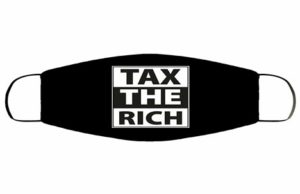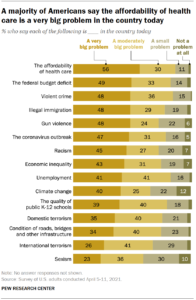Marty Levine
February 17, 2022

Last week the Chronicle of Philanthropy published its list of 2021’s 50 largest philanthropists. And they are large. In total, they contributed $25.48 billion dollars. The Chronicle list is led by Bill Gates and Melinda French Gates’ donations totaling $15 billion. The next three largest donors added $3.849 Billion to the total. The remaining 46 philanthropists averaged donations of almost $188 million. After publication by the Chronicle, it was learned that Elon Musk has made a gift of Tesla stock valued in excess of $5 billion bringing the total giving by the 51 largest donors to at least $30 billion. To put these numbers in context, total individual giving for in 2020, coming from an estimated 79 million households, was $324.1 billion, an average gift of just$4,100.
In choosing where to place these resources, these mega-donors had the ability to directly respond to a nation and a world in great disarray. 2021 was a year in which our nation had yet to get the COVID-19 pandemic under control. It was a year of continued debate about wealth and gender inequality, housing costs, racial and gender equity, and hate-inspired violence. It was a year of growing unemployment and worry about inflation. It was a year in which the structure of American democracy became increasingly frayed and threatened. It was a year of continued worry in many US households about their ability to maintain a quality life. It was a year in which evidence of how human-caused climate change was threatening lives across the globe.

A year ago the Pew Research Center, a source to be trusted, said this about the issues Americans’ were most focused on: “The affordability of health care is high on the public’s list of the biggest problems in the country today, with 56% of adults describing this as ‘a very big problem’ and an additional 30% rating it ‘a moderately big problem.’ Health care costs is the only issue of the 15 asked on the survey seen as a very big problem by a majority of Americans, though about half say that the federal budget deficit (49%), violent crime (48%), illegal immigration (48%) and gun violence (48%) are very big problems. A similar share (47%) name the coronavirus outbreak as a very big problem – though that is down significantly from last summer, when nearly six-in-ten (58%) said this.”
So how many of these concerns are reflected in the priorities of these large donors?
Not so many.
The Chronicle of Philanthropy noted these comments from Chuck Collins, director of the Program on Inequality and the Common Good at the Institute for Policy Studies, “From this list, you would not know that we’re living through a global pandemic, and you would not know that as a society we’re grappling with racial inequity. This gift list is completely disconnected from the reality of our society right now.”
Judge for yourself.
Going down the list of 2021 mega-donors we find large giving to non-operating charities. These are organizations that may, at some point, donate funds to an organization actually doing the work of charity but who can also hold those funds unused. For many of those making large donations last year it was time to build up their Foundations and Donor Advised Funds (DAFs they control), allowing them to decide how and when the funds that they have “given away” are used.
All of Mr. Gates and Ms. French Gates philanthropy is reported to have gone in one direction, increasing the size of the Gates Foundation. This continues a pattern. Between 2000 and 2020 the Chronicle estimates that they had already given $13.3 billion to the charitable organization that they control. Their 2021 generosity was to a Foundation that already ranked as the nation’s largest and which had assets of more $50 million.
And the Gates were not outliers. The list of “self-funders” included William Ackman and Neri Oxman who focused their $1.2 billion of generosity on growing their Pershing Square Foundation; the Bill Ackman and Neri Oxman Foundation, and the Oxman-Ackman Family Fund; Mark Zuckerberg and Priscilla Chan who divided all of their giving of $1.046 billion between the Chan Zuckerberg Donor Advised Fund at Silicon Valley Community Foundation and the Chan Zuckerberg Foundation; Jack Dorsey’s gifted to the Jack Dorsey Donor Advised Fund at Fidelity Charitable and other DAFs totaling an estimated $765 million; Sergei Brin and Nicole Shanahan who focused half their giving on the Sergey Brin Family Foundation ($464 million); Eric and Wendy Schmidt who added $383 million to three closely associated organizations; and Steve Ballmer gave $356 million to the Ballmer Group Donor Advised Fund at Goldman Sachs Philanthropy Fund.
In total, almost $20 Billion or 80% of the top 50 givers’ giving went to enrich their own Foundations and DAF’s. About 50% of all of the non-Gates donations still went to non-operating charities that remain under the control of the donor.
Where Elon Musk’s giving was directed remains unknown, but Eliza Haverstock, writing for Forbes, speculated that Mr. Musk, who would have been number two on the Chronicle list, followed this same pattern of parking his money at the taxpayers’ expense. She echoed my thinking in this piece when she wrote “What makes a lot more sense is that the money landed in a donor-advised fund (DAF), which behaves like a philanthropic bank account. DAFs are essentially black boxes…Money can sit in DAFs for years without ever going to an operating nonprofit group, which is why Forbes does not count such funds when measuring the biggest philanthropists—One of the advantages of giving stock to a DAF is that Musk receives the tax benefit of the gift—a tax deduction of as much as 30% of his 2021 adjusted gross income—as soon as he makes the donation, even though the shares are sitting in the equivalent of a philanthropic holding tank. A second scenario is that Musk could have pumped the money into his own foundation instead. In that case, he would still receive an immediate income tax deduction. But, unlike a gift directly to a DAF, foundations are required to disperse about 5% of assets annually…”
Large Universities and cultural organizations found themselves befitting from the choices these men and women made. But they were not organizations that were without resources and facing imminent danger.. Harvard University has an endowment estimated to exceed $40 billion when Penny Pritzker decided her highest philanthropic urgency was to give it another $100 million, all of her estimated personal giving in 2021. Patrick and Shirley Ryan donated $400 Million to Northwestern University who ended 2021 with assets in excess of $16 billion. The University of Wisconsin, the beneficiary of John and Tashia Morgridge’s gift of $135 million, has an endowment exceeding $4 billion. Other nonprofits that were given large gifts included the University of Chicago with an endowment valued in excess of $10 million, the Metropolitan Museum of Art which ended the year with assets in excess of $4 billion.
For some, there is nothing to be concerned about in this data. The funds being donated are the personal assets of these very fortunate men and women. Their wealth, some will argue, is the result of their hard work. How they choose to spend it is no one else’s concern.
I would beg to differ. This great wealth was amassed at a time when politicians have chosen to reward the accumulation of wealth by creating a tax system that prioritizes the individual over our collective needs. It has reduced tax levels on their earnings, on accumulated wealth, and on the passage of wealth from generation to generation so that these large personal fortunes can be built, some in just a few years. It has created a set of rules for philanthropy that allows donations, tax-deductible contributions to be made so at the direction of the donor to entities that can just warehouse the funds, giving little if any to actual service-providing organizations. It allows “donors” to “give” their money away to organizations that they continue to control, while still receiving the tax benefits of a charitable gift and while getting the accolades for being a generous philanthropist.
It also allows such independence that this giving need have no relationship to the state of our nation and the actual lives of people at risk. The way these large donors focus their philanthropy, its lack of relevance to the reality of people’s lives, makes the claim that philanthropy can fill the gap that an impoverished, frozen government creates ring very hollow. It even allows charitable funds to help support the political efforts of those who want to keep the government from acting in support of its people.
Each of the men and women on this top 50 list and others whose giving is large but not quite large enough to make the list may believe they are doing good. And in a vacuum, each gift may well be accomplishing a noble purpose. But by keeping such wealth in their hands, by allowing them to decide when to give and where to give, we are perpetuating a very flawed system.
The changes needed are not just tweaks.
We can change our tax laws so that charity must be charity; so that donations no longer can go to organizations that remain controlled by those who say they are giving their money away. This requires us to limit the ability of those who create Foundations and DAFs to control their decision-making process. This requires us to change our laws so that the tax benefits we give donors requires these funds to be used by operating charities, organizations that directly do the work of human support and problem solving and not remain parked in the investment portfolios of Foundations and DAFS waiting for the donor to decide when and if the money should actually be used for societal benefit.
It also requires us to end the hoarding of wealth that allows these men and women to make this list. To do this, none of the men and women on this list need to be reduced to poverty. They can live an extravagant lifestyle without being allowed to horde wealth as they do.. We can increase taxes on this wealth without reducing them to poverty. This will provide the resources needed by local, state, and federal elected officials to fund efforts that reflect our shared priorities and combat the threats we face.
Great wealth has empowered these men and women to influence public and private policy, a policy that directly affects all of our lives. It is time to take that power back.

1 Response
[…] inclination to increase the well-being of humankind by charitable aid or donations.” I have described the current legal and cultural structure as “a set of rules for philanthropy that allows […]